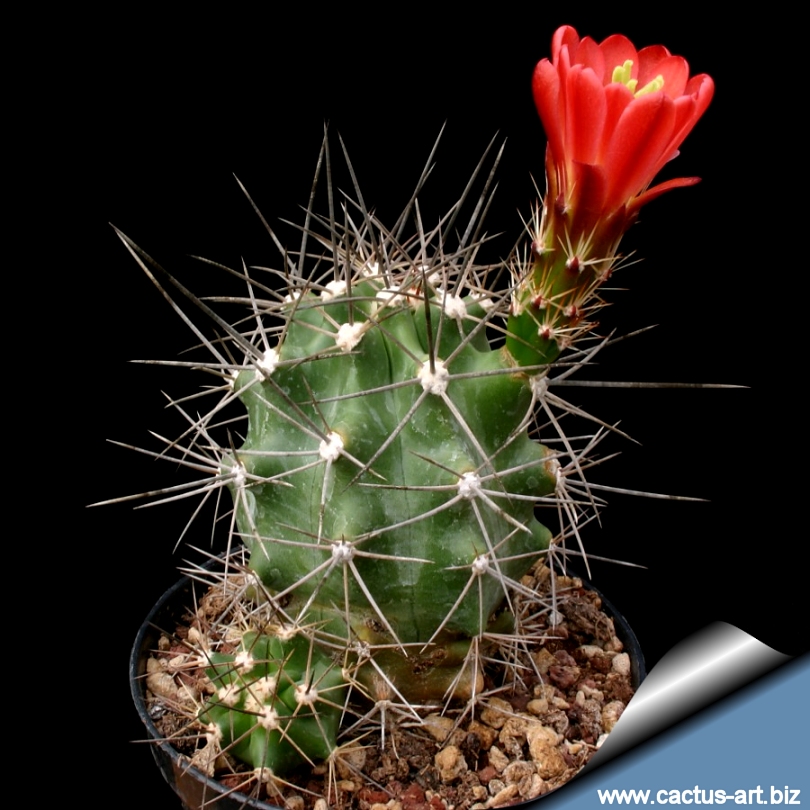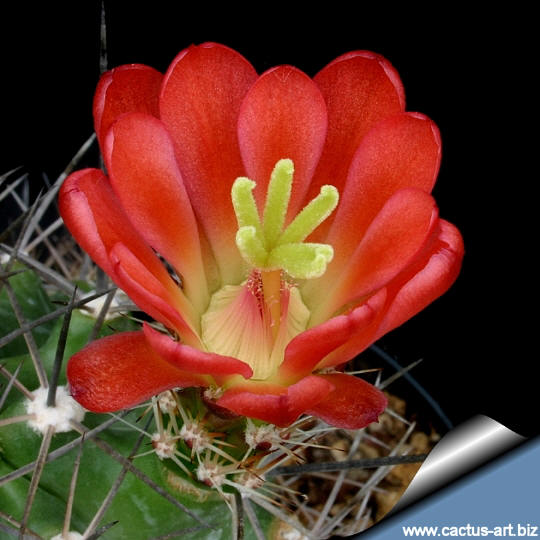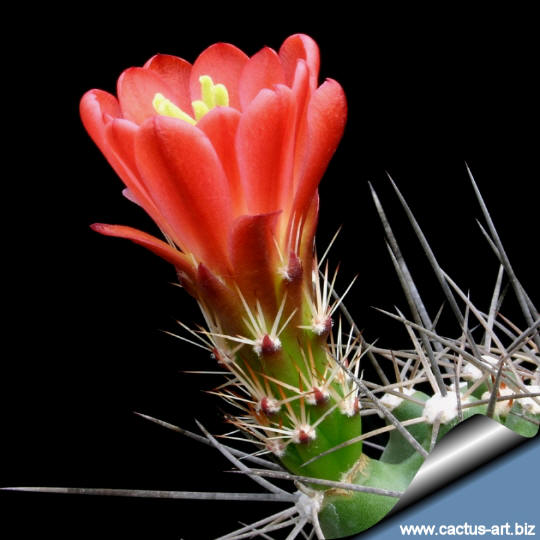|
|
|

E. coccineus SB402 Crocket Co. TX
|
|
Description: Usually clumping, often in large
colonies of many as 50 thick, stems on each plant at maturity.
Stems: Semi-erect, pale green, up to 40 cm tall, 6 cm in
diameter.
Ribs: 5 to 8 warty with narrow furrows.
Areoles: Whitish, 1-2 cm apart.
Central spine: 0 or 1 dark, up to 3.5 cm long;
Radial spines: 3 to 6 straight or not, 1.5-2 cm long yellowish
and turning grey after some years.
Flowers: Funnel shaped, hummingbird-attracting, scarlet with a
clear throat, length and width averaged 60 mm and 30 mm,
respectively, the petal tips are rounded, stigma with
7 or 8 lobes. Peak flowering comes from late April to June on mature
clumps.
Female and male flowers: Echinocereus coccineus is a cactus with
both hermaphroditic (bisexual) and dioecious (male and female) forms of
flowers in different plant. Male flower shows pollen-filled anthers
surrounding the base of the stigma lobes. While functional female flower
from different plants show reduced filaments and empty anther sacs held
below the stigma lobes.
The flowers appear specialized to hummingbirds but are also pollinated
by bees they are huge and highly rewarding, and daily nectar production
averaged 30 mg sugar/flower. This set of traits represents a syndrome
rare among hummingbird flowers in which the flower fits the head rather
than just the bill, and birds are well rewarded for a risky or
inconvenient visit.
|
|
Cultivation: It is
sensitive to overwatering (rot prone) needs a very good drainage to
avoid rotting, but requires more moisture than true desert cacti
to grow and produce flowers , Keep drier and cool in
winter. Need full sun. It is very cold resistant from -10° to
-25° C (depending on clones) or less for short
periods of time. It is a fine plant for a rock garden or
container, contrasts well with agaves, yuccas, and low-growing flowering
plants.
Propagation: Cutting as it branches freely from the base; Also can
be grown from seeds.
Photo of conspecific taxa,
varieties, forms and cultivars of Echinocereus coccineus.
|
|

 |
|
Advertising
|
|
|
|
|
Family:
Cactaceae (Cactus
Family) |
|
|
Scientific name:
Echinocereus coccineus var. paucispinus (Engelm.)
D.J.Ferguson 1989
Common Name: Scarlet hedgehog cactus.
Origin: Southwestern USA (Arizona, Colorado, New
Mexico, western Texas), Mexico (Sonora, Coahuila, Chihuahua)
Habitat: It is found growing on rocky outcroppings,
often in the partial-shade of oak and pine-oak woodlands and mixed
conifer forest.
Conservation status: Listed in
CITES appendix 2.
|
Synonyms:
- Cereus paucispinus Engelm. 1856
- Echinocereus coccineus subsp. paucispinus (Engelm.)
Blum et al. 1998.
- Echinocereus coccineus ssp. paucispinus (Engelm.) W.
Blum, Michael Lange & J. Rutow
- Echinocereus triglochidiatus var. paucispinus (Engelm.)
W.T.Marshall 1941
E. coccineus v. paucispinus is a
tetraploid form that was formerly considered (for its superficial
resemblance) a synonym of triglochidiatus, but may
be distinguished by its relatively terete and more consistently straight
spines and now is considered a distinct species.
|
|
|
|

A female flower with reduced filaments and empty anther sacs held
below the stigma lobes.

|
|